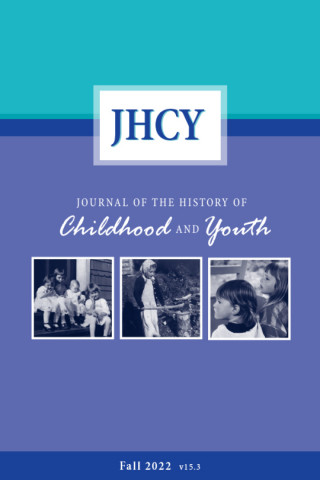Interview with Julia Gossard and Holly White about their co-edited special issue on “Double Age in the History of American Childhood and Youth”
Our members, Julia Gossard (Utah State University, US) and Holly White (Omohundro Institute of Early American History and Culture, US), talk about their co-edited special issue of the Journal of the History of Childhood and Youth.

Q: What are the main themes of this special issue?
The “Forum on Double Age in the History of American Childhood and Youth,” published in the Fall 2022 edition of the Journal of the History of Childhood and Youth, is a collaborative effort by historians Holly N.S. White, Julia M. Gossard, Sarah Mulhall Adelman, Courtney E. Thompson, Chelsea D. Chamberlain, William S. Bush, Erin Mysogland, and Susan J. Pearson to interrogate the concept of double age: the idea that one body can inhabit two ages at one time.
The eight essays included in this forum touch on a variety of themes including childhood and youth, age, race, class, gender, sexuality, criminalization, legal, social, and cultural history. Contributors approach double age as a way of identifying moments in which historical actors have asserted normative boundaries of childhood and youth while also weaponizing and manipulating age for specific ends.
The forum’s progression with case studies from the nineteenth century to the twentieth century demonstrates how age, especially double age, progressed from more abstract ideas to concrete definitions and diagnoses overtime in a variety of contexts from orphanages, to criminal cases, to scientific and pseudo-scientific studies, and to issues regarding immigration.
Q: What made you initiate this special issue?
Modern scientific findings suggest that the human brain does not reach full maturity until the age of twenty-five. In America, a child becomes a legal adult once they turn eighteen. Children of color (under the age of eighteen) are disproportionately tried and sentenced as adults in the American juvenile justice system in comparison to their fellow white youth.
How do we make sense of these contradictions in our current society? One way is to look to the past. This forum begins this inquiry by examining moments of double age to illuminate the tensions between childhood, youth, and aging in American culture and practice.
Double age serves various objectives, depending on who is assigning the age. When double age is employed for issues of social fear and control, often one’s maturity— whether physical or intellectual—is amplified, suggesting that one’s functional age is more important than chronological age.
An excerpt from the introductory article:
As historians of childhood and youth, we acknowledge the many ways that age, as a category of identity, has historically been manipulated, pathologized and criminalized to reinforce established power structures. By identifying and acknowledging moments in which authority figures imposed a second age upon a child to justify different treatment, we are reminded that lived experience does not always fit the neat models of age-grading and age laws that governments and institutions often assert. This forum takes an explicitly modern American perspective on the concept of double age though this phenomenon can certainly be identified across the world in various time periods. …
As a whole, “Forum on Double Age in the History of American Childhood and Youth” reveals that for states, communities, and organizations throughout the history of the United States, age has never simply been about a number of years. Instead, age and assumptions about it reveals the social anxieties around physical ability, mental acuity, and race. Especially for children of color, disabled children, and otherwise marginalized children, double age assists governmental authorities, institutional actors, medical doctors, and society-at-large to adultify them while simultaneously infantilizing idealized, white, “normative” children. Double age provides us a lens to explore these cultural, social, and political anxieties that involve children and youth. …
This forum is only a start to a larger conversation that can take hold in the history of childhood and youth. We invite scholars to carefully consider how double age can illuminate new understandings of the lived experience of childhood and youth. Similarly, through interrogating double age, we can better understand the complex and nuanced power dynamics that shape the lives of trans youth, those living through significant military conflict, and even youth who assert their own double age to their benefit.